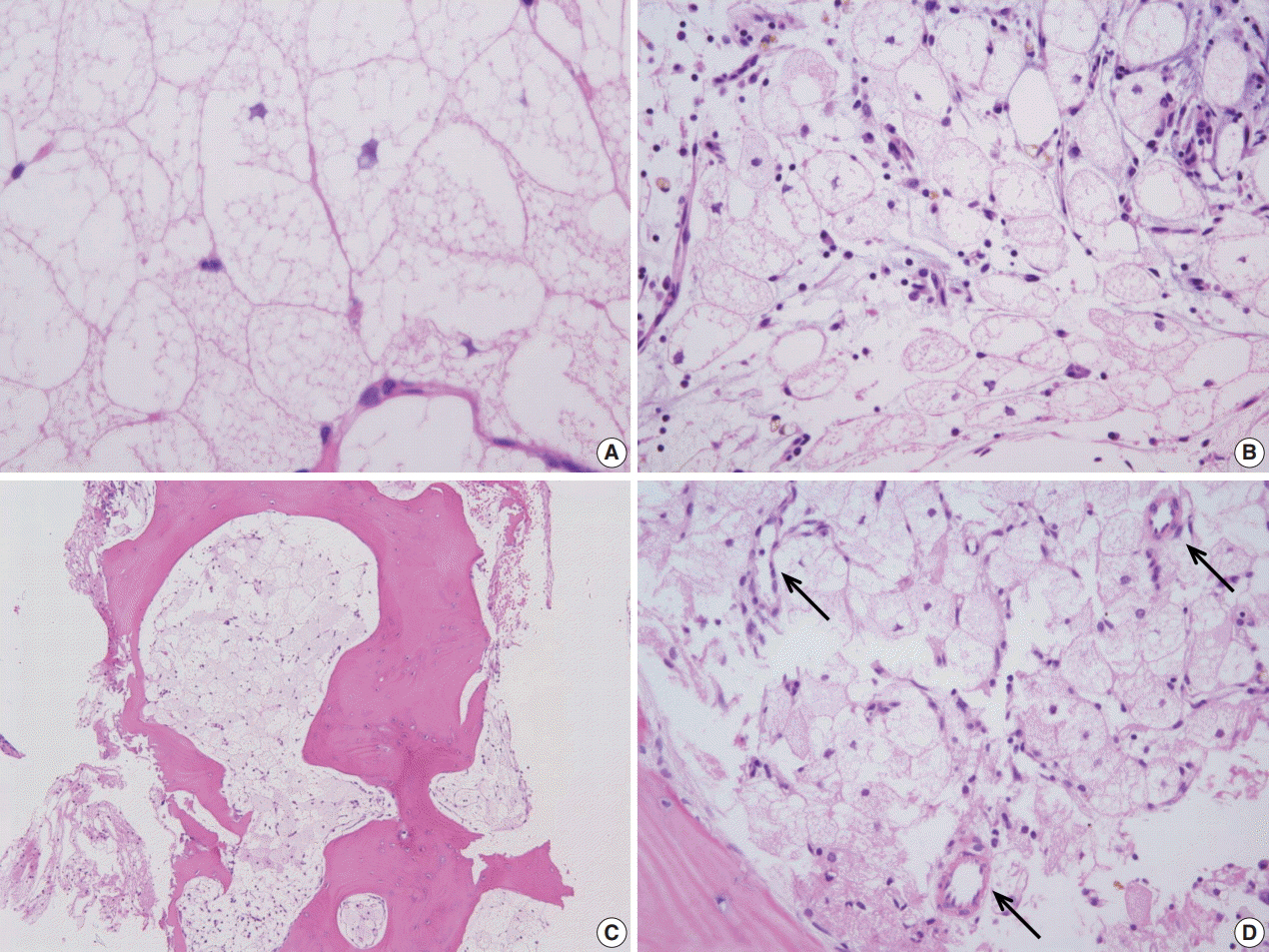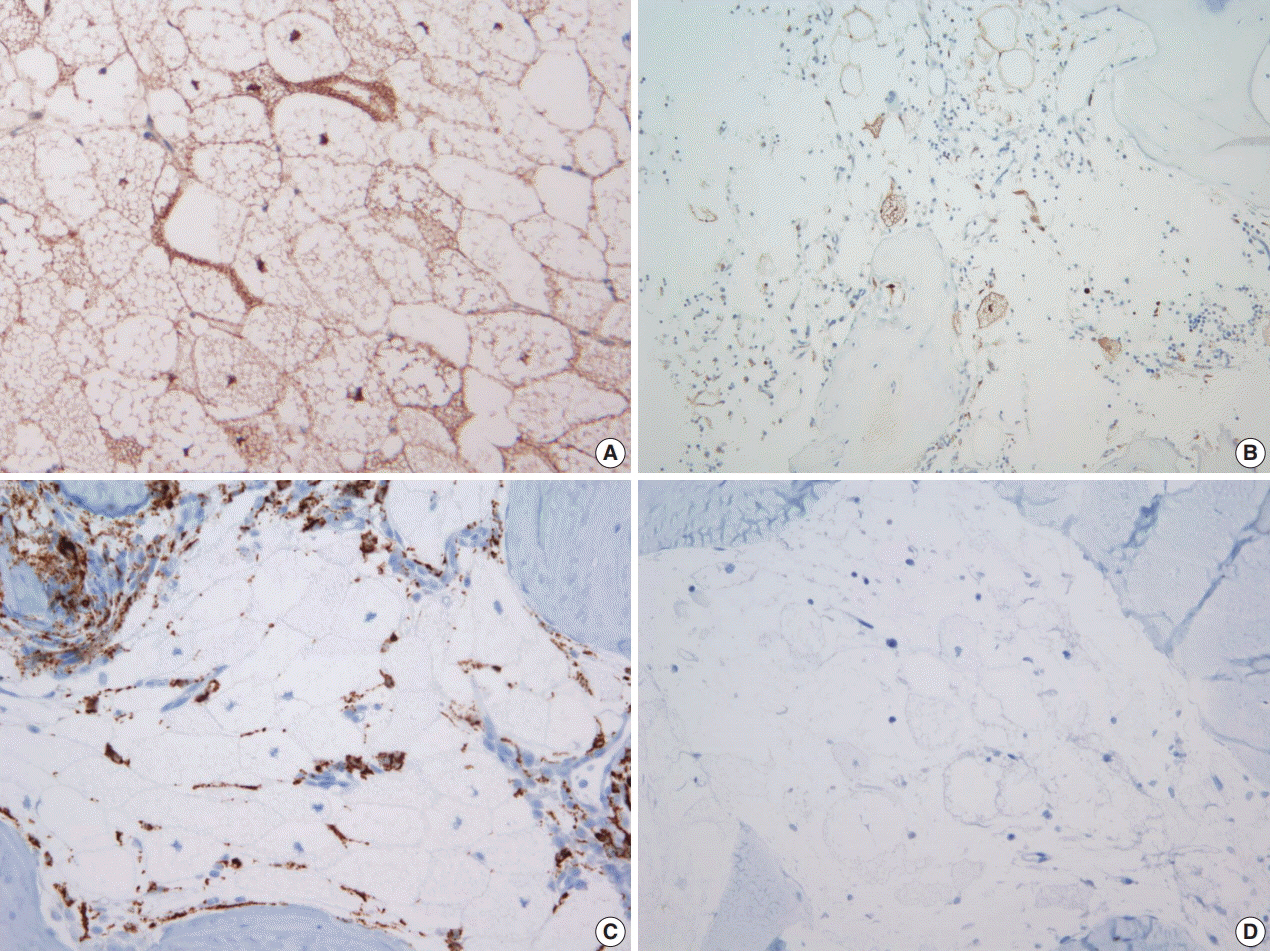J Pathol Transl Med.
2017 Sep;51(5):499-504. 10.4132/jptm.2017.07.28.
Intraosseous Hibernoma: A Rare and Unique Intraosseous Lesion
- Affiliations
-
- 1Department of Pathology, Seoul National University College of Medicine, Seoul, Korea. blue7270@snu.ac.kr
- 2Department of Radiology, Seoul National University College of Medicine, Seoul, Korea.
- 3Kidney Research Institute, Medical Research Center, Seoul National University College of Medicine, Seoul, Korea.
- KMID: 2392569
- DOI: http://doi.org/10.4132/jptm.2017.07.28
Abstract
- BACKGROUND
Hibernoma is a rare benign tumor of adults that is composed of multivacuolated adipocytes resembling brown fat cells. Hibernoma typically occurs in soft tissue, and intraosseous examples are very rare. Intraosseous hibernomas can radiologically mimic metastatic carcinoma and other tumorous conditions.
METHODS
To collect the intraosseous hibernomas, we searched the pathologic database and reviewed the hematoxylin and eosin (H&E)-stained slides of bone biopsy samples performed to differentiate radiologically abnormal bone lesions from 2006 to 2016. A total of six intraosseous hibernoma cases were collected, and clinical and radiological information was verified from electronic medical records. H&E slide review and immunohistochemical staining for CD68, pan-cytokeratin, and S-100 protein were performed.
RESULTS
Magnetic resonance imaging of intraosseous hibernomas showed low signal intensity with slightly hyperintense foci on T1 and intermediate to high signal intensity on T2 weighted images. Intraosseous hibernomas appeared as heterogeneous sclerotic lesions with trabecular thickening on computed tomography scans and revealed mild hypermetabolism on positron emission tomography scans. Histopathologically, the bone marrow space was replaced by sheets of multivacuolated, foamy adipocytes resembling brown fat cells, without destruction of bone trabeculae. In immunohistochemical analysis, the tumor cells were negative for CD68 and pan-cytokeratin and positive for S-100 protein.
CONCLUSIONS
Intraosseous hibernoma is very rare. This tumor can be overlooked due to its rarity and resemblance to bone marrow fat. Pathologists need to be aware of this entity to avoid misdiagnosis of this rare lesion.
Keyword
MeSH Terms
Figure
Reference
-
1. Furlong MA, Fanburg-Smith JC, Miettinen M. The morphologic spectrum of hibernoma: a clinicopathologic study of 170 cases. Am J Surg Pathol. 2001; 25:809–14.2. Merkel H. On a pseudolipoma of the breast. Beitr Pathol Anat. 1906; 39:152–7.3. Gery L. In discussion of MF Bonnel’s paper. Bull Mem Soc Anat (Paris). 1914; 89:111–2.4. Thorns C, Schardt C, Katenkamp D, Kähler C, Merz H, Feller AC. Hibernoma-like brown fat in the bone marrow: report of a unique case. Virchows Arch. 2008; 452:343–5.
Article5. Kumar R, Deaver MT, Czerniak BA, Madewell JE. Intraosseous hibernoma. Skeletal Radiol. 2011; 40:641–5.
Article6. Lynch DT, Dabney RS, Andrews JM. Intraosseous hibernoma or unusual location of brown fat? J Hematopathol. 2013; 6:151–3.
Article7. Bai S, Mies C, Stephenson J, Zhang PJ. Intraosseous hibernoma: a potential mimic of metastatic carcinoma. Ann Diagn Pathol. 2013; 17:204–6.
Article8. Botchu R, Puls F, Hock YL, et al. Intraosseous hibernoma: a case report and review of the literature. Skeletal Radiol. 2013; 42:1003–5.
Article9. Ringe KI, Rosenthal H, Langer F, Callies T, Wacker F, Raatschen HJ. Radiofrequency ablation of a rare case of an intraosseous hibernoma causing therapy-refractory pain. J Vasc Interv Radiol. 2013; 24:1754–6.10. Bonar SF, Watson G, Gragnaniello C, Seex K, Magnussen J, Ear-waker J. Intraosseous hibernoma: characterization of five cases and literature review. Skeletal Radiol. 2014; 43:939–46.
Article11. Dannheim K, Bhargava P. A rare finding of brown fat in bone marrow as a mimic for metastatic disease. Am J Hematol. 2016; 91:545–6.
Article12. Vlychou M, Teh J, Whitwell D, Athanasou NA. Intraosseous hibernoma: a rare adipocytic bone tumour. Skeletal Radiol. 2016; 45:1565–9.
Article13. Westacott L, Collins A, Dickenson I. Intraosseous hibernoma in the sacrum of an adult. Int J Surg Pathol. 2016; 24:749–52.
Article14. Himms-Hagen J. Brown adipose tissue thermogenesis: interdisciplinary studies. FASEB J. 1990; 4:2890–8.15. van Marken Lichtenbelt WD, Vanhommerig JW, Smulders NM, et al. Cold-activated brown adipose tissue in healthy men. N Engl J Med. 2009; 360:1500–8.
Article16. Peer S, Kühberger R, Dessl A, Judmaier W. MR imaging findings in hibernoma. Skeletal Radiol. 1997; 26:507.
Article17. Lee JC, Gupta A, Saifuddin A, et al. Hibernoma: MRI features in eight consecutive cases. Clin Radiol. 2006; 61:1029–34.
Article18. Gaffney EF, Hargreaves HK, Semple E, Vellios F. Hibernoma: distinctive light and electron microscopic features and relationship to brown adipose tissue. Hum Pathol. 1983; 14:677–87.
Article19. Eyzaguirre E, Liqiang W, Karla GM, Rajendra K, Alberto A, Gatalica Z. Intraosseous lipoma: a clinical, radiologic, and pathologic study of 5 cases. Ann Diagn Pathol. 2007; 11:320–5.
Article20. Nombela-Arrieta C, Ritz J, Silberstein LE. The elusive nature and function of mesenchymal stem cells. Nat Rev Mol Cell Biol. 2011; 12:126–31.
Article21. Celi FS. Brown adipose tissue: when it pays to be inefficient. N Engl J Med. 2009; 360:1553–6.




